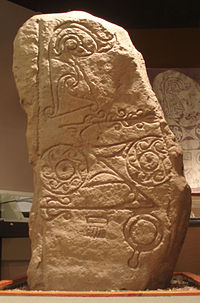- Dunnichen Stone
-
Coordinates: 56°38′39″N 2°53′21″W / 56.6441°N 2.8891°W
The Dunnichen Stone 
The Dunnichen StoneMaterial Old Red Sandstone Size 1.5 metres (4.9 ft) Created Seventh Century CE Discovered 1811, near Dunnichen, Angus, Scotland Present location Meffan Institute, Forfar, Angus, Scotland The Dunnichen Stone is a class I Pictish symbol stone that was discovered in 1811 at Dunnichen, Angus.
Contents
Location
The exact location at which the stone was found is unknown, but thought to be in a field in the East Mains of Dunnichen, on the SE slope of Dunnichen Hill, (grid reference NO51654960), overlooking Dunnichen Moss.[1] It is currently on display at the Meffan Institute in Forfar (grid reference NO455506).[2]
History
Jervise relates that the stone was found in a field called the Chashel or Castle Park, and that the site later became a quarry.[3] While this name is no longer extant, Headrick records that it was in East Mains of Dunnichen,[4] and the location was later assigned in 1966 at a disused quarry on that farm.[1]
The discovery was described by Headrick:
[...] a good many years ago, there was turned up with the plough a large flat stone, on which is cut a rude outline of an armed warrior's head and shoulders [4]
Jervise, noting the inaccuracy of description, identifies this confidently with the extant Dunnichen Stone.[3]
The stone was initially erected at the unidentified "Kirkton Church", either in Dunnichen or in Letham, then it was moved to the garden of Dunnichen House. It was relocated to St Vigeans Museum in 1967, then to Dundee Museum (now the McManus Galleries) in 1972.[5] It is currently on long-term loan to the Meffan Institute in Forfar.[2]
A replica stands at the Church in Dunnichen.
Description
The stone is of rough sandstone, 1.5 meters (4 foot 8 inches) high, 0.7 meters (2 foot 3 inches) wide and 0.3 meters (1 foot) thick.[1] It is incised on one face with three symbols: a pictish flower; a double disc and Z-rod; and a mirror and comb. While the double disc and Z-rod and mirror and comb motifs are fairly common and exist together elsewhere (see for example the Aberlemno Serpent Stone, the Flower is relatively rare.
References
- ^ a b c "Dunnichen (Pictish symbol stone), site record", Royal Commission on the Ancient and Historic Monuments of Scotland, http://canmore.rcahms.gov.uk/en/site/34684/details/dunnichen/, retrieved July 29, 2010
- ^ a b "Pictish Carved Stone Collection", Meffan Museum and Art Gallery, http://www.angus.gov.uk/history/museums/meffan/pictish.htm, retrieved July 29, 2009
- ^ a b Jervise, Andrew (1857), "Notices descriptive of the localities of certain sculptured stone monuments in Forfarshire, &c (Part i.)", Proceedings of the Society of Antiquaries of Scotland 2: 187–201, http://ads.ahds.ac.uk/catalogue/adsdata/PSAS_2002/pdf/vol_002/2_187_201.pdf, retrieved July 27, 2010
- ^ a b Headrick, James (1845), "Parish of Dunnichen", New Statistical Account of Scotland, http://books.google.co.uk/books?id=PqACAAAAMAAJ&pg=PA142, retrieved July 27, 2010
- ^ "Dunnichen Pictish Symbol Stone", Royal Commission on the Ancient and Historical Monuments of Scotland, http://canmore.rcahms.gov.uk/en/site/34684/details/dunnichen/, retrieved July 27, 2010
Aberlemno Sculptured Stones · Bullion Stone · Camus Cross · Drosten Stone · Dunnichen Stone · Dupplin Cross · Eassie Stone · Glamis Manse Stone · Hunter's Hill Stone · Meigle standing stones · Monifieth Sculptured Stones · St Orland's Stone · Woodwrae StoneCategories:
Wikimedia Foundation. 2010.

